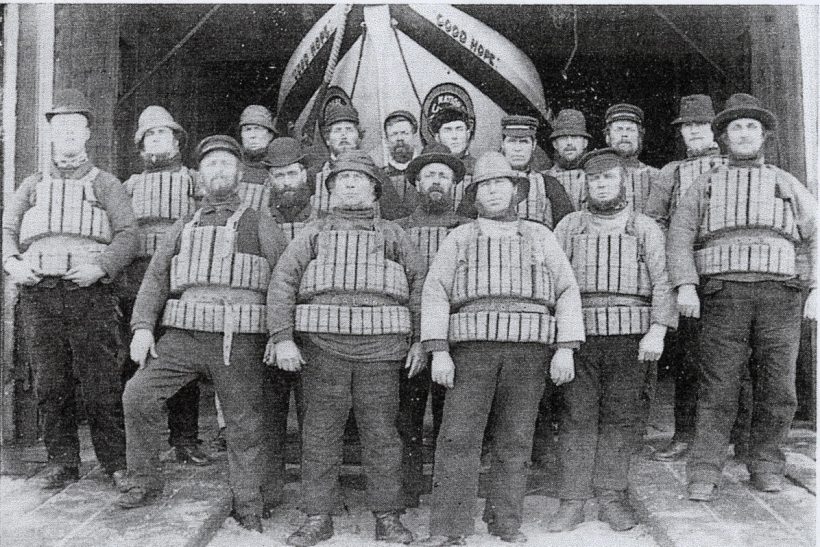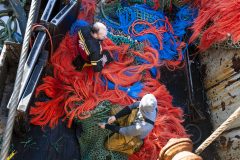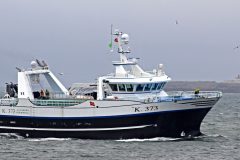In the days before lifeboat services, saving lives at sea went hand in hand with the chance to make serious money from salvage, reports John Worrall
It was a question of time and place.
In the 18th and 19th centuries, off the eroding East Anglian coast, where longshore drift built sediments into shoals to trap any number of ships – not least the countless colliers on the Tyne to London run – salvage developed into a big market opportunity for those with the knowledge and the nerve. And given the rewards on offer, the nerve wasn’t hard to find.
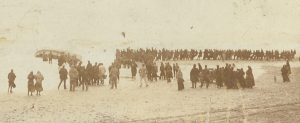
Onlookers watch as the grounded Caister lifeboat Beauchamp is hauled ashore in 1901. Capsized in the surf, it lost nine of its crew.
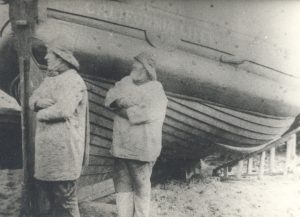
The private lifeboat Prince Albert at California, the coastal colony founded by the eponymous company – both so named because gold coins were found in the cliff at the time of the California gold rush. By the mid-19th century, wealthy benefactors had stationed lifeboats at most settlements on this stretch of coast, before the RNLI had fully taken over.

The Trio of Guernsey ashore on the Norfolk coast in the 1890s, although judging by the crabber in attendance, fishermen got to her before any beach company. Either way, she survived to sail another day. She was wrecked in 1939.
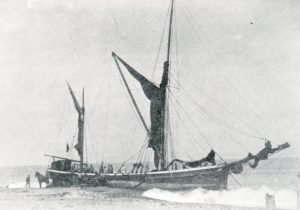
The sailing barge Service ashore at Eccles, just up from Palling, in 1906. The Palling men are offloading coal into carts before attempting to refloat her.

Scroby Sands, just off Great Yarmouth, caught out a few ships in the days of sail. Now it houses a wind farm and, in recent years, four or five thousand seals.

The rudder of the Bittern, a noted racing yawl, outside the Sailors’ Reading Room in Southwold.

Winterton’s lookout in the 1890s. A similar structure at Caister was struck by lightning and demolished in 1910.
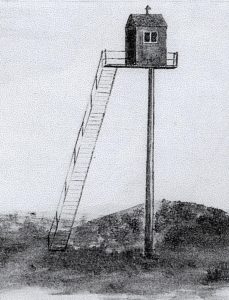
The Sea Palling lookout – by the look of it, an even more dangerous place than a yawl in a high wind. Unsurprisingly, it was destroyed by a storm in 1897.
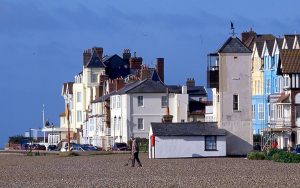
The lookout, on the right, of Aldeburgh’s Old Company, photographed in 2005. The town companies had a bit more general carrying work – and a bit more money.
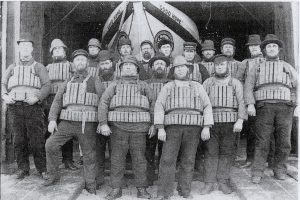
The Palling beachmen in 1888.
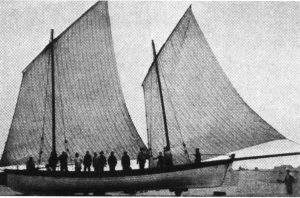
The yawl Happy Return, showing the sail pattern with the mizzen sheeted to the long bumkin. That dipping lug, though a powerful propellant, was a handful to get around the mast on tacking, and could be caught aback by a sudden wind shift, with potentially disastrous consequences.
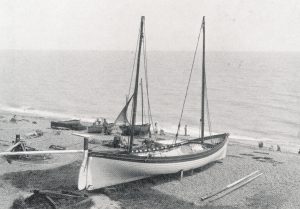
Nice lines – a yawl on Southwold beach around 1890.
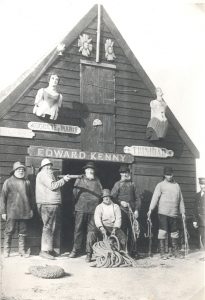
The Old Company of Lowestoft, looking suitably nautical outside their shed in the 1890s. A lookout tower was added in the early 20th century.
Thus did the beach companies form up to work the niche, helping vessels in distress and saving lives but, more particularly, claiming salvage from ships’ owners. That was the money-spinner: getting abandoned ships off the sandbanks or the beach and to a port, as intact as possible.
It followed, then, that business was best where sailing was worst, and the shoal-ridden stretch between Mundesley in northeast Norfolk and Aldeburgh in Suffolk became known as the Beachmen’s Coast. That’s where ships came to grief, especially in a wind from a northerly or easterly quarter. Thirty or so companies were working that reach in the early 19th century – not companies in the legal sense, though each had its own rules, but groupings of men with a common purpose. Most settlements had at least one; Great Yarmouth, at one time, had seven.
The beach companies grew out of the longshore fishing fraternities, probably starting in the 17th century, although there are no records as such of them then. Already working their boats from shallow beaches, and well versed in the tricky art of launching through surf, the fishermen had always grouped together in mutual help – but knowing the ground and its channels, they were well placed to help any ships in trouble. And as they got better at it, and saw the money to be made, they began to kit out for the job, and make sure there was always a crew on the beach to look out for work and seize opportunities.
The favoured craft was the yawl – or ‘yoll’ in the parlance: an open workboat, 40ft to 70ft long, which came in broadly two types.
The beamier version tended to be used for the less dangerous jobs – anchor sweeping, carrying out to the Roads and didling for coal around sunken colliers. In autumn, these boats would help to land the annual herring catch from the drifters, getting it quickly to the beach for packing and sale.
The sleeker version could do much of that too, but its additional speed was also suited to salvage, because the unwritten but cast-iron rule was that the first boat to reach a casualty got the job.
They were originally three-masted, but in the mid-19th century, the main mast was abandoned and a big dipping lug-sail was set on the foremast, complemented by a suitably large mizzen. They were clinker-built and usually double-ended, and to sail properly, they needed a crew of a dozen or more to handle that big foresail around the mast on tacking, while at the same time shifting two tonnes of shingle ballast in bags from one bilge to the other. But they were fast, and could be sailed with the lee rail a foot below the surface, and men baling whatever little water the speed didn’t keep out.
Racing them brought a recreational dimension to an otherwise serious business, and noted performers included the 49ft Bittern of Southwold, built in 1890 and memorialised by a model in the Sailors’ Reading Room there and her rudder mounted on a post outside. And despite their size, yawls could be rowed in calm weather, and some had eight or nine thwarts with square oar ports, which could be closed with wooden shutters when the vessel was under sail.
The companies also used other boats such as skiffs, gigs and cutters and, because lifesaving was very much part of the job, they were the first to get purpose-built lifeboats, courtesy of various wealthy benefactors who were appalled at the loss of life and aware of the shortcomings of the yawls in very rough seas. The first lifeboat was stationed at Lowestoft in 1801, but by the mid-19th century, nearly every beachmen’s settlement had one.
Companies working out of towns such as Yarmouth, Gorleston, Lowestoft, Southwold and Aldeburgh found plenty of employment carrying supplies, passengers, pilots and cargos between shore and ships, especially those moored in Yarmouth Roads – which is why Yarmouth had so many. And there was the sweeping for lost anchors, of which there were plenty.
But the biggest returns came from the dangerous salvage of stranded vessels, and the ‘village’ companies competed hard for that action. They didn’t get much involved in carrying – there wasn’t much to carry from villages, except pilots occasionally – but concentrated on salvage and rescue to supplement their fishing income.
Typically, the early companies had just a single boat and a membership of up to 25 beachmen – enough to give half a chance of having a crew to hand at any given time. Members generally had a share in proceeds, and there were rarely outside investors. With their yawl on the beach, close to their gear shed, they would keep watch from lofty – and often rickety – lookout towers or platforms, from where they would hope to spot ships in trouble before another company did.
There was a bit of life or death about it in more than one respect, because a big salvage could bring temporary riches, but a dearth meant that time on the beach was time lost and, with not much in the way of social security, that could quickly reflect on the dinner table. And there was a rule with most companies that any member who could touch the boat being launched would be entitled to a cut of the job’s proceeds, even if they didn’t manage to get aboard, and so occasionally there would be latecomers rushing into the surf to try to at least touch the boat – though they were no doubt pressured into doing a full shift the next time.
It bred fierce competition between companies. Take one event in April 1856, when a vessel got into distress in the difficult Cockle Gateway off Caister. The Caister and California companies both launched, but Caister got there first. When the California crew arrived and one Henry Brown tried to board, Jacob George of the Caister crew ‘caught him by the throat and struck him violently, endeavouring to break his hold away and threatening to throw him in the sea’. In the event, the ship’s master, still aboard, obviously didn’t like the look of either crew and declined to employ them, presumably then going on to sort out the problem himself.
Caister had a much better day on 29 November, 1801, when the company had an uncontested job after the brigantine Aberdeen Merchant of Sunderland, sailing from Hull for London, grounded on the Outer Barber Sand. The crew abandoned ship, and after two hours made an exhausted landfall at Yarmouth. But the brigantine survived the night, much to the delight of the Caister beachmen, who boarded her and, after making repairs, got her off and anchored her in the Roads. They were awarded £200.64 for their day’s work – and this was at a time when an agricultural labourer’s annual wage was £20-£25.
But given the number of companies looking out along the coast, much more likely would be a convoluted scenario like that surrounding the Betsy which, in 1802, went on the Haisborough Sands and lost her rudder. She was abandoned, but was spotted from the shore at first light, and companies from Winterton, Happisburgh and Caister all launched. The Winterton men, reckoned to be the best of the bunch at the time, sent three boats, of which a large yawl arrived first, soon to be joined by that company’s other two.
But a cod smack then pitched up, her skipper launching a skiff and offering assistance. With the Betsy rudderless, the beachmen knew they would need a smack to tie on and help steer her, but they didn’t want it to have any claim. They told the skipper that they would throw him off if he boarded, but if he lay to, they might hire him.
The Caister boat arrived next and tried to board, but was repelled with handspikes and boathooks and retired hurt.
The Betsy was then refloated, and the beachmen duly hired the smack for a flat fee to tie on to the stern, to give steering through the Cockle Gateway.
Meanwhile, the Betsy’s master, who had rowed for two miles, decided to return, anxiously aware of the big difference between a payment for salvaging a deserted vessel and one for assisting a boat in difficulties with its crew still aboard.
But he saw that he was too late, because the Winterton men had got her underway – at which point he encountered the Happisburgh crew, who had been hampered by contrary winds. He asked them to take him to the Betsy but, with her now too far to windward, they eventually decided that it was a lost cause. So he landed with them back at Happisburgh, and went to Yarmouth to try to regain his ship.
Meanwhile, a Revenue cutter entered the picture, boarding even before the Winterton men noticed – though when they did, a row ensued, tempered only by the fact that throwing government officers overboard was a touch more serious than ditching a competing crew. They were allowed to stay. The Winterton men’s protectiveness eventually earned them an award of £1,230 – about £40 a man.
Sometimes companies spent too much time arguing, as in October 1801, when the barque Henrietta of Danzig also struck the Haisborough Sands. The crew abandoned, later claiming to be going for help, as most crews did after the event, though in fairness – to them, anyway – they had left two dogs onboard. Landing on Happisburgh beach and finding a company boat preparing to go off, they asked to be taken back to the barque. There followed some lengthy haggling, after which it was agreed that one man would be taken – but while they argued, a fishing boat snuck alongside the Henrietta, and when the Happisburgh company eventually got there, they found her in the possession of its master who, now in pole position, was able to reduce them to the level of subcontractor in getting the barque off. He was later awarded £469 4s. 5d. – much of which he would have been able to keep, even after paying the Happisburgh men.
Then there was the occasional diversionary tactic to get possession, as in February 1810, when the schooner Ney Prove of Copenhagen, bound for London, struck the Newarp Sand, keeled over, filled with water and was abandoned – although again, the crew later claimed to be merely going for help. Her boats landed at Winterton, where the master and pilot went to a pub to seek beachmen to take them back to the schooner. But sensing an opportunity, the Winterton men played for time until they could launch two yawls – and then the master and pilot were ushered into one which immediately took them to Yarmouth harbour, where they were obliged to wait for four hours. By the time they were eventually taken to the vessel, the other yawl had boarded and got her underway. The court awarded the beachmen £276 5s. – a fifth of the value of the vessel and cargo.
But sometimes, it was the beachmen on the receiving end. On one occasion in the 1870s, a schooner was seen coming through that treacherous Cockle Gateway with a signal flying from the main peak. The weather was squally with snow showers, and the Caister company, sensing some business, launched. But when they drew close, they found that the skipper had hoisted the signal in the hope of getting a tug. The company account of the event states that they were ‘laughed at by the master and well abused with strong language. Returned to station’.
Very occasionally, their skills let them down. In 1885, the skipper of Caister’s yawl Zephyr, after a night launch in calm moonlit conditions, uttered the famous last words: “Now, dear boys, keep a lookout for that old stump,” referring to the mast of a stone-laden schooner, the crew of which had been saved by the Caister men some nine years earlier. No sooner had he said it than the yawl struck the mast and the boat was ripped open. Eight of the crew drowned.
And sometimes, the weather was just too bad, a sudden wind shift putting that big dipping lug sail aback, and with the ballast thus suddenly on the lee side, bringing almost instantaneous capsize. That’s what happened to the Increase, in 1835, when the leaking Spanish brig Paquette de Bilboa had signaled for a pilot. Three men had been put aboard to help with the pumps, and the yawl was making its way back when it sank. Eight men died, and another swam for seven and a half hours and was picked up 14 miles away.
In 1838, the Lowestoft yawl Peace was one of two responding in competition to a schooner’s request for a pilot, but the schooner stood out to sea, and although both yawls turned back, the Peace wasn’t heard of again, leaving its company with no boat with which to continue working, and 12 widows and 32 children destitute.
Another disaster befell Caister with the capsize of the lifeboat Beauchamp which, in response to distress signals on the Barber Sand one stormy November night in 1901, had been launched – after a three-hour struggle and a change of crew – into the surf. No one knew that by then, the ship in trouble had been washed off the sand and was anchored. Finally scrambling back to the beach, the Beauchamp grounded, was caught on its quarter by a big wave, turned over and trapped the crew underneath. Nine died.
That was the other side of the beachmen’s coin, the lifesaving and the life losing – for although they were regarded by some seamen as longshore sharks, they saved many lives before the RNLI came fully into the picture, and they lost many themselves. And in the end, as the oft-quoted Caister beachman James Haylett put it, when asked by a judge at an inquest if they cashed in on the misfortunes of others: “No, sir, we profit from their mistakes.”
Further reading:
The Beachmen by David Higgins
Saved from the Seas by Robert Malster
Once Upon a Tide by Harvey Benham
All archive photographs courtesy of Time and Tide Museum, Blackfriars Road, Great Yarmouth. Tel. 01493 743930. museums.norfolk.gov.uk/time-tide



